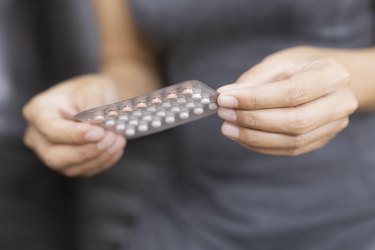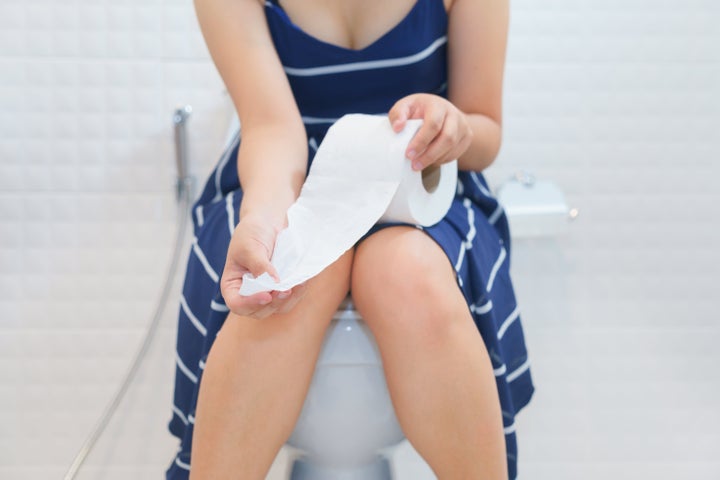Why Do I Keep Getting Yeast Infections
Talk with your doctor before making any changes to your antibiotic regimen.
Keep Getting Yeast Infections? Here’s What Your Body’s Trying to Tell You

The majority of people with vaginas will get a yeast infection at least once, or maybe even twice, in their lifetime. But is it normal for them to practically be a regular thing?
Vaginal yeast infections are caused by an overgrowth of the fungus candida albicans. They’re typically marked by intense vaginal itching or irritation, redness or swelling, burning while urinating and vaginal discharge that can be watery or white and cottage cheese-like, according to the Mayo Clinic.
Video of the Day
Yeast infections are considered recurring if a person has four or more of them per year. When that happens, they’re typically triggered by an underlying cause that needs to be addressed.
Here are the most common culprits behind recurrent yeast infections and what you can do to find relief.
1. You’re Taking Antibiotics Too Often
Antibiotics can kill off the bad bacteria that’s causing an infection, but they can kill off beneficial bugs too, including good bacteria in the vagina.
That can set the stage for yeast like candida to grow out of control and cause an infection, especially if someone is taking antibiotics frequently, says Felice Gersh, MD, ob-gyn and founder and director of the Integrative Medical Group of Irvine in Irvine, California.
Fix it: If you’re taking antibiotics regularly or often, reducing your use (or switching to another antibiotic) can help bring your vaginal bacteria back into balance, making it harder for yeast infections to develop. (Eating certain foods while taking antibiotics might help too.)
Talk with your doctor before making any changes to your antibiotic regimen.
2. Your Birth Control Isn’t a Good Fit
Hormonal fluctuations caused by birth control options like the pill can create a vaginal environment that’s more prone to yeast infections, according to the Cleveland Clinic.
This isn’t always the case, as different studies have shown different results when it comes to hormonal birth control and the immune response, according to a February 2022 paper in Cancers. It seems to depend on the individual, the hormonal dose and the method of delivery (oral vs. vaginal, for example), and how they all react together.
Fix it: Recurring yeast infections may be a sign that your birth control isn’t a good fit.
Talk with your gynecologist about trying a contraceptive with a different hormonal dose or method of delivery. Research in the November 2012 issue of Contraception suggests that the vaginal ring may be a better fit.
3. You’re Douching or Using Vaginal Sprays
Both can disrupt the vagina’s normal bacteria environment and increase the chances for yeast overgrowth or other infections like bacterial vaginosis, according to the Office on Women’s Health.
And if you have an existing yeast infection, douching could actually make the problem worse.
Fix it: When showering or bathing, wash your vulva (the outside of your vagina) with warm water and, if you’d like, a mild, unscented soap, the Office on Women’s Health recommends.
The vagina is self-cleaning, so there’s no need to use cleanses or sprays to wash it. If you’re concerned about vaginal odor, talk with your gynecologist.
4. You Have a Blood Sugar Imbalance
Insulin resistance caused by prediabetes, diabetes or polycystic ovary syndrome (PCOS) is another common trigger for recurring yeast infections, Dr. Gersh says. Blood sugar imbalances can cause excess sugar to accumulate in the urine, which can affect the vaginal environment and set the stage for yeast growth.
Fix it: Talk with your primary care provider if your blood sugar isn’t well controlled. Together, you can determine whether lifestyle changes like diet and exercise can address the problem or whether you need to take medication to get your blood sugar back into balance, per the Centers for Disease Control and Prevention (CDC).
5. You’re Pregnant
The normal (but very extreme) hormonal fluctuations that happen during pregnancy can disrupt the vagina’s natural acidity levels and make yeast infections more likely, the Mayo Clinic notes.
Pregnancy can also weaken the immune system, making it harder for the body to fight off developing infections, Dr. Gersh says.
Fix it: Pregnancy-related yeast infections will typically ease up after giving birth, once your hormones stabilize.
In the meantime, practice habits to reduce your chances for infection (more on those below) and talk with your provider about taking an over-the-counter cream, ointment or suppository such as clotrimazole, miconazole or terconazole. These medications are safe to take during pregnancy, according to the Mayo Clinic.
6. You Have a Weakened Immune System
Medical conditions such as HIV or using certain medications (like chemotherapy, steroids or post-organ transplant drugs) can weaken the immune system, making it harder for the body to fight off infections, including yeast infections, per UpToDate.com.
Fix it: Talk with your doctor if you’re experiencing recurrent yeast infections alongside a condition or medication that’s suppressing your immune system. Together you can decide on the best steps to reduce your infection risk and discuss whether it’s possible to change medications.
7. Your Clothes Are Too Tight
Frequently wearing tight bottoms — especially ones made of synthetic materials — won’t alone cause a yeast infection. But it can increase your odds, especially if you have other risk factors.
“If all of the variables are aligned with an infection, it’s possible that recurring yeast infections will be the default position and occur continuously,” Dr. Gersh says.
Fix it: Start by talking with your doctor to address any potential underlying issues that could be setting the stage for yeast infections, like those mentioned above. While you take steps to address those, make it a point to wear bottoms that are made of natural, breathable materials (like cotton) and have a looser fit.
How to Fix a Yeast Infection
Yeast infections can typically be treated with over-the-counter antifungal creams, ointments, suppositories or tablets. But if you keep getting yeast infections, you may need to be treated with up to a six-month course of prescription antifungals, per the Office on Women’s Health.
“Some newer vaginal yeast infection medications have come out for the treatment of resistant strains,” Dr. Gersh says.
Lifestyle changes won’t clear an existing infection, but they can help reduce the likelihood that a cleared infection comes back. Some strategies to try:
- Avoid douching or using vaginal cleansers, sprays or powders, which can disrupt the healthy bacteria in your vagina and encourage the overgrowth of yeast.
- Wipe from front to back after using the bathroom.
- Wear breathable, loose-fitting bottoms made from natural materials like cotton.
- Eat yogurt or take a vaginal support probiotic. Eating eight ounces a day or taking Lactobacillus acidophilus capsules may help reduce infection risk, the Office on Women’s Health notes.
- Support your overall health by getting enough sleep and keeping your stress levels in check, Dr. Gersh recommends.
When to See a Doctor About Recurring Yeast Infections
See your doctor if you’re experiencing more than four yeast infections a year, or if at-home treatments haven’t been enough to clear your yeast infection after two weeks, Dr. Gersh recommends.
Your provider can prescribe a more powerful antifungal to help clear the infection, and if needed, help you address any underlying factors that could be causing the yeast infections to recur.
Why Do I Keep Getting Yeast Infections?

Symptoms of yeast infections are unmissable (hello, itchiness and discharge). The issue is one of the more frustrating realities of living with a vagina.
Yeast infections are very common (at least 80 percent of women will experience one in their lifetime, according to Kimberly Langdon, a retired OB/GYN who currently serves as a medical advisor at health services company Medzino Health. But some may be more prone to yeast infections than others. And if you find yourself plagued with recurring infections, there may be some specific factors to blame.
Advertisement
Here are a few of the most common reasons you may be getting yeast infections plus advice from medical experts on how to deal with them:
It might not be a yeast infection.

If you’re self-diagnosing, your guess might be off. According to Mary Jane Minkin , an OB/GYN and clinical professor in the department of obstetrics, gynecology and reproductive sciences at the Yale University School of Medicine, “about a third of the time, a woman will indeed have a yeast infection if she is self-diagnosing. About a third of the time, she will have another type of infection, like a bacterial infection. And another third of the time, the woman will have some irritation from an allergen, like bubble bath, soap, a new detergent), which comes in contact with her vulva which mimics the itchiness and irritation of yeast.”
Minkin said that if you suspect you’re having recurring yeast infections, it’s important to get a professional opinion. “See your OB/GYN care provider for a culture and an exam, as you may indeed have something very different,” she said.
Advertisement
It could be your medication.
If your doctor prescribed you a course of antibiotics to fight off an infection, the pills may have also wiped out some of the “good bacteria” in your body in the process. Langdon said that this bacteria, known as lactobacillus, is crucial in maintaining the normal acidic pH of the vagina. Thus, having antibiotics kill it off can lead to a yeast infection.
If you have to take the medication, Minkin suggested also popping a probiotic to introduce more good bacteria into your body. And pay attention to other medications, too: Birth control and steroids may also contribute to yeast infections, added Natasha Bhuyan , a physician at the primary care network One Medical in Phoenix.
You’re using the wrong over-the-counter treatment.

Your local pharmacy sells many products designed to treat yeast infections ― but they might not always be beneficial in treating your specific infection.
“Over-the-counter antifungal medications may not work for every strain of yeast,” said Craig Salcido, an OB/GYN at Mission Hospital in Orange County, California. If the Monistat isn’t cutting it, for instance, Salcido said you may need a prescription to treat your yeast infection. “If your yeast infection keeps coming back, then it’s time to see a doctor,” he said.
Advertisement
Salcido added that it’s important to complete the full course of treatment in order to properly wipe out the infection, even if your symptoms go away. “Incomplete treatment may not reduce the yeast down to a level the body can handle,” he said.
Blame it on outside factors, like condoms or soap.
Yeast infections are primarily caused by anything that changes your typical vaginal flora, like spermicide, certain types of condoms or sperm itself, Bhuyan added that even soaps ― especially scented ones ― or douching can cause yeast infections, not prevent them, as some may be led to believe. “Which is why I advise patients to avoid douching . vaginas have their own natural cleansing system,” she said.
You’re stressed out.

A 2013 study from Germany found that psychosocial factors ― especially stress ― played a role in recurrent vaginal yeast infections, said Ceppie Merry , a practicing physician in Dublin, Ireland.
Salcido agreed, noting that stress can cause fluctuations in estrogen, which can trigger a yeast infection. Changes in estrogen levels from birth control, pregnancy or perimenopause can also lead to the growth of yeast, he said.
Advertisement
If you notice that you get more yeast infections when you are feeling high-strung, try addressing the underlying stressors, said Diana Ramos, an OB/GYN and chair of the National Preconception Health and Health Care Initiative (PCHHC) , public-private partnership of 100+ organizations working to improve the health and wellness of young adults and advance quality women-centered health care. “And make sure you are eating well, sleeping and exercising to decrease your stress,” she added.
You’re living in dirty workout clothes
Do you find yourself hitting the gym hard and then lingering in your sweaty clothes afterwards? That could be leading to your discomfort. “A warm, wet and dark environment is the perfect breeding ground for yeast,” Salcido said. “This includes workout clothes and swimsuits.”
To prevent yeast infections, he suggested wearing loose-fitting cotton clothing at the gym or making sure to change out of tight yoga pants right after class.
You’ve got an underlying medical condition.

In more rare instances, yeast infections can be caused by an illness or disease. “Anything that lowers immunity such as HIV infection, chemotherapy, severe underlying illness or diabetes will leave one prone to fungus infections,” said Laurence Gerlis, founder of SameDayDoctor , a branch of medical clinics in the United Kingdom.
Advertisement
Ultimately, make sure to get a doctor’s opinion on anything if you’re ever unsure. Yeast infections ― whether they’re recurring or a one-time situation ― can be easily diagnosed and treated by a physician.
“Searching for Normal” is HuffPost’s attempt to answer some of the internet’s most pressing queries: Is it normal to ____? Why am I ___? Why do I ___?






